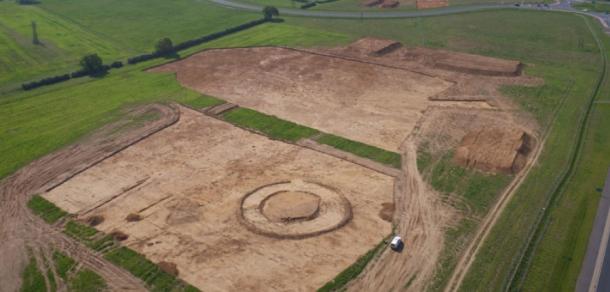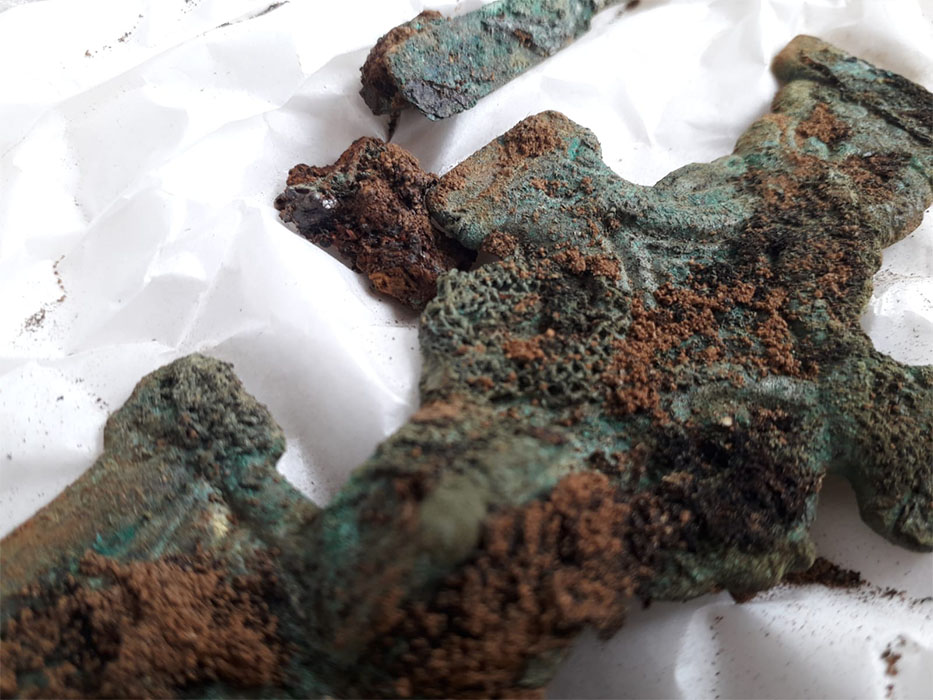Anglo-Saxon Settlement And Cemetery Complex Excavated In England
A vast Anglo-Saxon settlement and cemetery complex has been discovered in England that is being called a “one of a kind” discovery. Not, however, because the site was found laden with gold and silver, but because the thousands of recovered artifacts speak of the day to day lives of people who have inhabited the region since 4000 BC.
Whenever new construction is green lit in the UK, prior to any digging, archaeologists survey the site for any signs of ancient habitation. These must be tense times where the construction teams are praying nothing is found that might cause delays, while at the same time the archaeologists are dreaming of finding ancient objects. This was recently the case at Overstone Leys in Northamptonshire, England, where ahead of a new housing development project a team of archaeologists from the Museum of London Archaeology (MOLA) discovered the largest Anglo-Saxon complex ever found in the county.

Excavations at the huge Anglo-Saxon complex uncovered at Overstone, Northamptonshire. (MOLA)
Large Anglo-Saxon Complex and 4000 Years Of Life
The excavations were funded by Barratt and David Wilson Homes as a part of their pre-construction planning requirements. The team of researchers discovered evidence showing human activity at the site since the Bronze Age, nearly 4,000 years ago, right up to the Anglo-Saxon period, around 450 to 1066 AD. Simon Markus, Project Manager, said on MOLA’s website that the Overstone Leys site contains “by far the biggest Anglo-Saxon cemetery ever found in Northamptonshire.”
John Dillion, Managing Director at Barratt and David Wilson Homes South Midlands said, “it is amazing to think that people have been building homes on this site for around 4,000 years.” The vast 37-acre (15-hectare) site, spanning over 4000 years of history, is being described as “rare” by archaeologists, because both an Anglo-Saxon settlementand a cemetery were discovered during a single excavation.

A beautiful and ornate Saxon brooch found at the Overstone site. (MOLA)
The Anglo-Saxon Overstone Site Yields Countless Artifacts
Looking at the site as a whole the archaeologists unearthed the foundations of three Bronze Age round barrows, 46 prehistoric burials, and the outlines of four Bronze Age buildings. And built upon these deeply-ancient structures the team found evidence of a previously unknown Anglo-Saxon settlement comprising “22 structures, with 20 further buildings found scattered around the site,” according to MOLA.
- Shadows of the Dead: Anglo-Saxon Burials are Spooky Sand Silhouettes
- Metal Detectorist’s Hoard Leads to Twenty ‘Richly Adorned’ Anglo-Saxon Burials
- How Anglo-Saxon England Made the Radical Change to Christianity
The team unearthed a total of 154 individual Anglo-Saxon burials that were found to contain, in total, nearly 3000 ornate grave goods. The inventory of discoveries includes “150 brooches, 15 rings, 2000 beads, 75 wrist clasps and 15 chatelaines (a decorative belt hook or clasp worn at the waist with a series of chains suspended from it), cosmetic kits and bone combs.” The excavators also found collections of weapons including “25 spears, 40 knives and 15 shield bosses.”
Simon Markus from MOLA said his team of researchers also discovered “human remains.” Analysis of the human remains is expected to inform the researchers about the people's diets, their states of health, and their ancient origins. The newly discovered buildings will also teach us more about the day-to-day lives of people in the region, and how they lived within, and interacted with, the local and extended landscapes during, and between, the Bronze Age and Anglo-Saxon period in England.

Beads and brooches found in one of the Overstone site graves. (MOLA)
The Anglo-Saxon Layers Of Northumberland
Northamptonshire's countryside hosted early human occupation from the Paleolithic, Mesolithic and Neolithic periods, until about 500 BC, when the Iron Age was introduced by the Hallstatt culture from the European mainland.
A series of hillforts were constructed over the next century and by the 1st century BC, what would later became Northamptonshire, became part of the territory of the Catuvellauni tribe, who were themselves conquered by the Romans in 43 AD.
The Watling Street Roman road passed through the important Roman settlement of Lactodorum, which stood on the site of modern-day Towcaster. After the Romans left, the area became part of the Anglo-Saxon kingdom of Mercia. The Mercians eventually converted to Christianity in 654 AD, at which time the district, which is now Northamptonshire, saw waves of Saxon invasions, and this site was an important community center for all these warring, mixing and mingling cultures.
Top image: Preserved textile found on a Saxon brooch from the huge Overstone site recently discovered at Northamptonshire. Source: MOLA
By Ashley Cowie




















Comments
The brooch picture looks like a sword hilt with part of the blade. An empowering image back then I believe, to have that binding a cloak or something together.